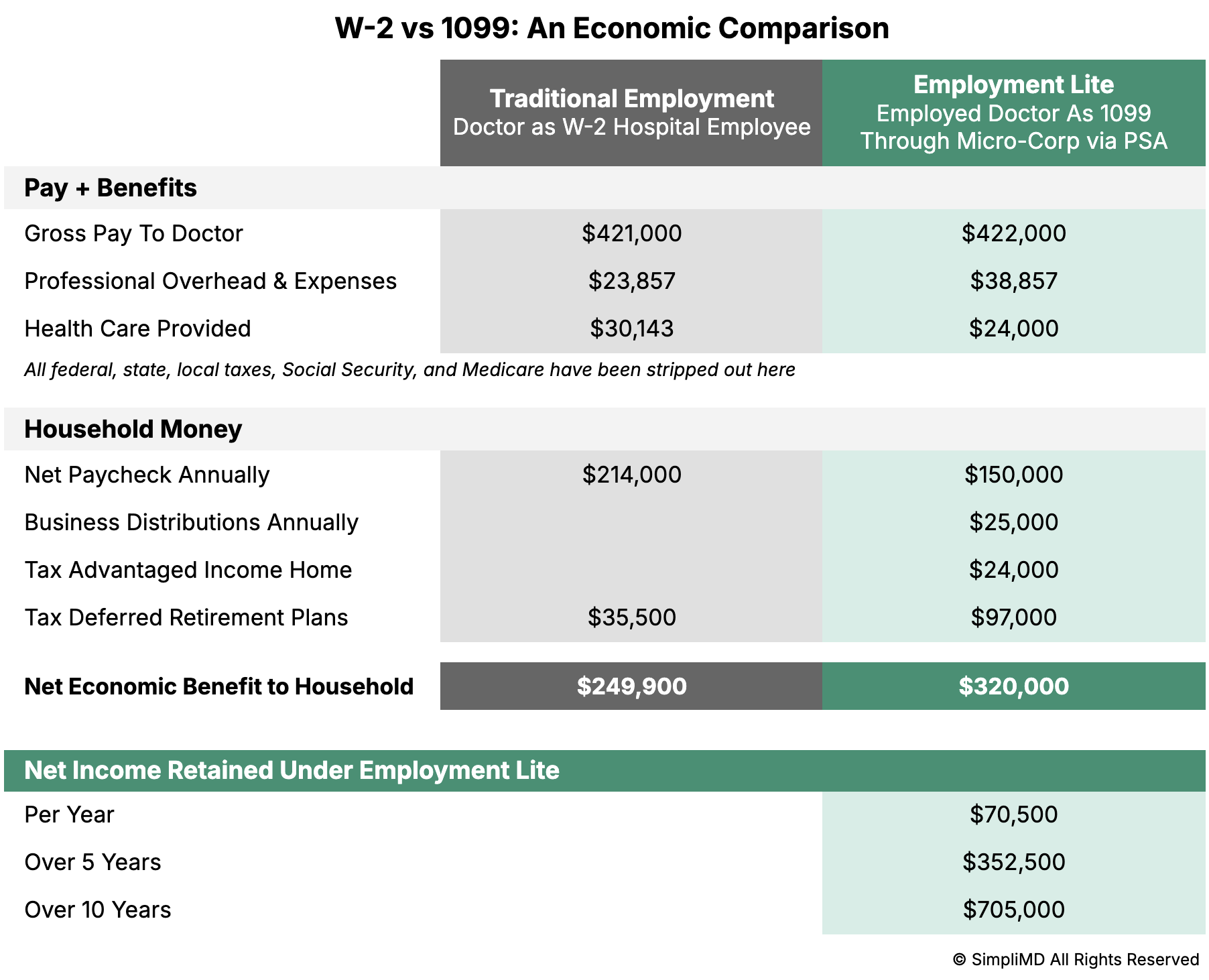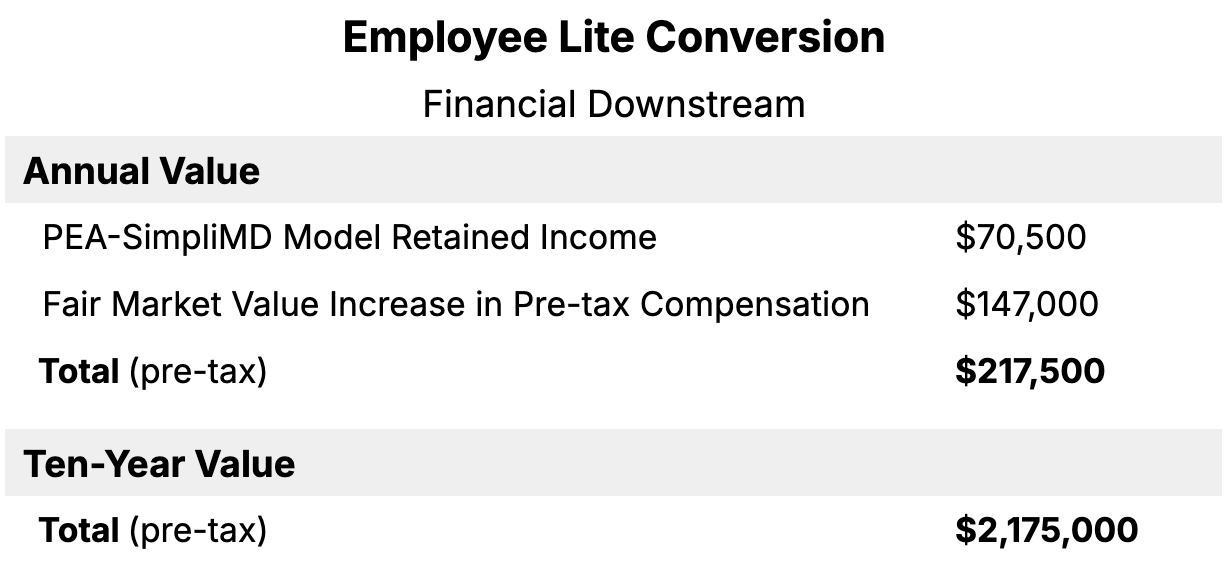Know Your Value: How I Gave Myself a Pay Raise Without Changing Employers or Moving
.png)
Most physicians assume that the only way to make more money is to work more hours or switch employers. I used to believe that too, until I hit a professional wall.
I was a high-performing, loyal rural family physician with a large patient panel and strong relationships. But after years of being a good “corporate citizen” for my hospital employer, I found myself frustrated, overworked, and undervalued. I didn’t want to uproot my family to change employers. My hospital employer was typical of most rural locations; it had complete control of the market and was the only show in town. I felt stuck, but something had to change. The last straw came when they asked me to take a pay cut.
What I discovered through that professional crisis, and what I want to share with you, is this: you have options beyond traditional employment, and you can give yourself a significant raise without changing jobs or moving cities.
It starts by doing one thing most physicians never take time to do: Know your value.
The Invisible Ceiling
My employer decided to adjust their compensation plan and place a cap or “ceiling” on it. Even though I was a highly productive full-spectrum family doctor doing inpatient care and surgical obstetrics who generated millions in downstream revenue, they informed me that I had reached the maximum pay allowed and would therefore be getting a pay cut. I was stunned.
That’s when I took stock, with the help of outside business consultants, and did a deep dive into my true value in the medical marketplace. What I discovered transformed not only my compensation, but also my professional autonomy and personal well-being.
Here’s what I learned to evaluate:
1. Fair Market Value ≠ Your Current Paycheck
Most doctors don’t realize they’re underpaid, especially when they’re on an RVU model. My consultants helped me analyze MGMA benchmarks, revealing that I was earning well below FMV, even before the compensation cap. (You can compare your own compensation using Marit’s physician salary data.)
2. No Non-Compete = Leverage
I had no non-compete clause in my contract, which meant my services and my patient panel were up for grabs in the open market. It was a reminder of how much power (and risk) can live in the fine print. If you’ve never taken a close look at yours, see Marit's post on how to know whether a contract review can help.
3. Your Patient Panel = Market Share
Healthcare employers don’t just want you; they want access to your patients. Recognizing that I controlled a substantial share of the market helped me reframe my value to my employer.
4. Downstream Revenue is Often Ignored
I was generating $3–5 million in downstream revenue, but that wasn’t reflected in my compensation. Knowing that gave me a stronger position to advocate for myself, even though, due to Stark Laws, it cannot be translated into compensation.
Activating My Small Business Superpower
The real turning point came when I decided to transition to a blend of private practice and employment called “employment lite”, which is a little-known practice model. In essence, I didn’t leave my employer; I simply restructured the business relationship by becoming an independent contractor through a Professional Corporation (PC), and my contract was changed from an “employment agreement” to a “professional services agreement”.
Financially and professionally, this did several things. First, the terms of my compensation were no longer constrained by the employee compensation matrix; rather, I could negotiate my contract individually (which I did to ensure it aligned with my true FMV). Secondly, I monetized all the professional work I had been doing for free, such as taking unassigned OB call and Newborn/Peds calls for the hospital, nursing home work, and supervising NPs. (For more on call pay, see Marit's blog post here.)
This all gave me:
- More control over my professional life
- More tax efficiency with my earnings
- More income streams
- Less reliance on a single employer with greater independence as a contractor
Same Paycheck, Higher Net Income A Pay Raise Without More Work
Before jumping into this new model, I worked with my CPA to create a side by side comparison of my traditional employment versus working as an independent contractor through an employment lite agreement. I wanted to compare apples to apples, using the same compensation as a starting point in each model. The results are shown below.

I received the same paycheck, but retained $70,000 more in annual income because I could now:
- Deduct professional and household expenses as business costs
- Pay my spouse as an employee
- Customize my health and retirement benefits
- Shift income into tax-advantaged channels

How the Employment Lite Model Works
To visually compare my two compensation structures, here’s what the models look like:
.png)
In an Employment Lite arrangement, a physician keeps working within their existing organization but shifts from being a W-2 employee to contracting through their own professional micro-corporation. Instead of an employment agreement, the relationship is governed by a professional services agreement between the physician’s corporation and the healthcare employer.
Here’s how the structure flows:
- The Corporate Employer pays the physician’s corporation a fair market value (FMV) rate for professional services. The employer continues to bill patients and payers, collect revenue, and manage overhead - just as before.
- The Physician’s Micro-Corporation provides the actual medical services under the contract.
- The Physician, now functioning as an independent business owner, is responsible for their own compensation, benefits, and malpractice coverage.
This structure creates a balanced partnership: the corporate entity still receives the clinical revenue it depends on, while the physician gains more control over income streams, tax efficiency, and leverage over how professional value is recognized.
A Pay Raise Without More Work
Once the PC structure was in place, I negotiated a new independent contractor-style agreement using MGMA-based wRVU compensation, because I was no longer technically an employee. That gave me another nearly $150,000 annually in added, pre-tax household income. When viewed from a 10-year perspective, this transition was worth over $2 million to me!

The Psychological Payoff
The benefits went far beyond money or business structure. For the first time in years, I felt in control of my time, energy, and future. I set up a team-based care model with nurse scribes. I negotiated call pay and eliminated free “corporate citizen” work. I moved to a four-day workweek and took Mondays off . I purchased my own medical office building and leased it to my employer. And most importantly, I finally felt like a physician and a professional.
The Hidden Barriers to Employment Lite
If this model is so advantageous, why don’t more doctors do it? The answer lies on both sides of the employment table.
From the employer’s side, large health systems often act as gatekeepers. Converting employed physicians into independent contractors means giving up a measure of control over scheduling, productivity tracking, and even how physicians think about their professional worth. Many organizations quietly discourage the Employment Lite model because it shifts negotiating power back to the physician. PSA’s are often part of their “hidden menu” of contracts that they offer doctors. You won’t be offered it unless you specifically ask for it.
From the physician’s side, the biggest obstacle is fear, specifically the fear of running a business. Most of us were never taught how to read a profit-and-loss statement, hire a CPA, or file quarterly taxes. Business illiteracy keeps many doctors dependent on the simplicity of a W-2 paycheck, even when it limits their income and autonomy. In reality, a professional micro-corporation is far simpler to operate than a private practice. You have no staff to manage, no billing to chase, and no insurance contracts to maintain. You are the business.
With the right CPA and a bit of business coaching (I offer this at PEA), the “micro-corporation” behind an Employment Lite arrangement can be set up, maintained, and optimized in just a few hours a month. The learning curve is short, and the payoff, both financial and psychological, is transformative.
Know Your Value, Then Structure Around It
If you're like most doctors, you’ve been taught to assume your employer knows best and will fairly compensate you. But in reality, many physicians are under-compensated, not because they’re underperforming, but because they haven’t taken control of their professional life or advocated for themselves to have agency in the marketplace.
Here’s the truth about getting a pay raise:
- You don’t need to move
- You don’t need to switch employers
- You don’t need to work more hours
You just need to know your value and dare to structure your career around it.
Dr. Tod Stillson is the author of Doctor Incorporated: Stop the Insanity of Traditional Employment and Preserve Your Professional Autonomy and the founder of the Physician Entrepreneur Academy (PEA-SimpliMD). He helps doctors build professional micro-businesses that increase income, autonomy, and well-being.


